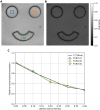Quantum holography with undetected light
- PMID: 35030021
- PMCID: PMC8759747
- DOI: 10.1126/sciadv.abl4301
Quantum holography with undetected light
Abstract
Holography exploits the interference of a light field reflected/transmitted from an object with a reference beam to obtain a reconstruction of the spatial shape of the object. Classical holography techniques have been very successful in diverse areas such as microscopy, manufacturing technology, and basic science. However, detection constraints for wavelengths outside the visible range restrict the applications for imaging and sensing in general. For overcoming these detection limitations, we implement phase-shifting holography with nonclassical states of light, where we exploit quantum interference between two-photon probability amplitudes in a nonlinear interferometer. We demonstrate that it allows retrieving the spatial shape (amplitude and phase) of the photons transmitted/reflected from the object and thus obtaining an image of the object despite those photons are never detected. Moreover, there is no need to use a well-characterized reference beam, since the two-photon scheme already makes use of one of the photons as reference for holography.
Figures






References
-
- Xu F., Ma X., Zhang Q., Lo H.-K., Pan J.-W., Secure quantum key distribution with realistic devices. Rev. Mod. Phys. 92, 025002 (2020).
-
- Wengerowsky S., Siddarth Koduru J., Steinlechner F., Zichi J. R., Liu B., Scheidl T., Dobrovolskiy S. M., van der Molen R., Los J. W. N., Zwiller V., Versteegh M. A. M., Mura A., Calonico D., Inguscio M., Zeilinger A., Xuereb A., Ursin R., Passively stable distribution of polarisation entanglement over 192 km of deployed optical fibre. npj Quantum Inf. 6, 5 (2020).
-
- E. Ortega, K. Dovzhik, J. Fuenzalida, S. Wengerowsky, J. C. Alvarado-Zacarias, R. F. Shiozaki, R. Amezcua-Correa, M. Bohmann, R. Ursin, Experimental space-division multiplexed polarization entanglement distribution through a 19-path multicore fiber. arXiv [preprint] arXiv:2103.10791 [quant-ph] (2021).
-
- Zhong H.-S., Wang H., Deng Y.-H., Chen M.-C., Peng L.-C., Luo Y.-H., Qin J., Wu D., Ding X., Hu Y., Hu P., Yang X.-Y., Zhang W.-J., Li H., Li Y., Jiang X., Gan L., Yang G., You L., Wang Z., Li L., Liu N.-L., Lu C.-Y., Pan J.-W., Quantum computational advantage using photons. Science 370, 1460–1463 (2020). - PubMed
-
- Brida G., Genovese M., Berchera I. R., Experimental realization of sub-shot-noise quantum imaging. Nat. Photonics 4, 227–230 (2010).
LinkOut - more resources
Full Text Sources

